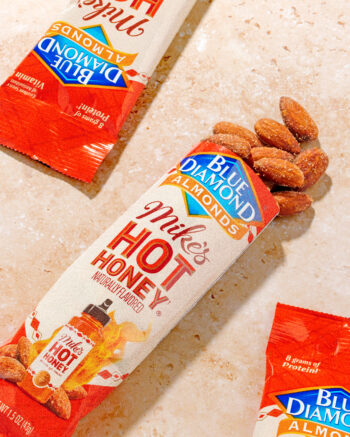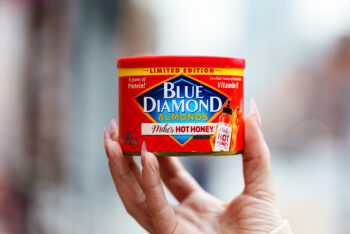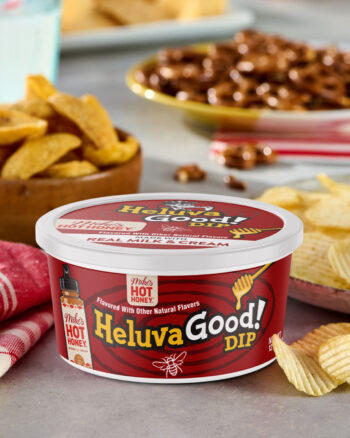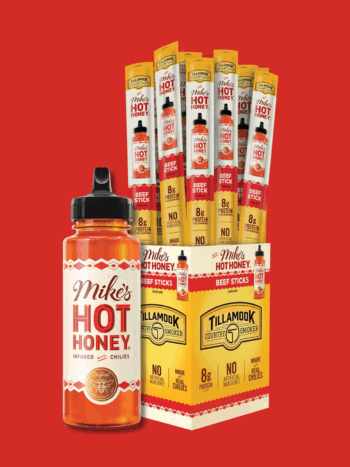By Gary Symons
TLL Editor in Chief
Food and beverage licensing is one of the largest, and most complex, categories in licensing.
The business involves the creative genius of master chefs, combined with complex manufacturing processes, imaginative marketing, and the market savvy to identify the hottest food trends before they even happen.
Last year it was the sweet and spicy—or ‘Swicy’—trend that dominated in 2024-25, largely brought about by Brandgenuity’s client Mike’s Hot Honey, which went from a pizza condiment to a widely used flavor within a multitude of other licensed products.
So, when we wanted to talk about ingenuity in creating successful flavor collaborations, we went to the source, Brandgenuity and their client, Mike’s Hot Honey
Jay Asher, Partner at Brandgenuity, says the company sees flavor as the critical element for food licensing.
“When we think about food-to-food licensing, flavor is often the key point of difference, and the reason for being in a licensed product,” Asher says. “A distinctive flavor profile gives the brand real authority and unlocks meaningful storytelling across categories.
“It’s not just about putting a logo on a box; it’s about delivering a taste experience that consumers already know and love, in a new context.”
That’s exactly what happened with Mike’s Hot Honey, which started as a condiment at a pizzeria, and then exploded as a massively popular food brand in just one year.
That, as Asher points out, was no accident.
“Brandgenuity began representing Mike’s Hot Honey in 2022 as the brand was on a growth trajectory across retail, and cementing itself as the original hot honey brand,” Asher recalls. “As an agency, and along with our client, we have been nimble and fast-moving while following our trusted process to ensure all of the proper milestones are hit.
“A lot depends on the licensee’s capabilities, innovation pipeline and retailer windows, but when a brand and flavor are on fire, like Mike’s Hot Honey, everyone figures out a way to get it done quickly!”
In fact, Asher says the example of Mike’s Hot Honey shows that knowing how to create collaborations based on flavor profiles is key to food and beverage licensing programs. While there are many partnerships that involve extending a food brand into other products—from toys to apparel—it’s flavor that’s at the core of the business.
“It’s essential in extending food and beverage brands into other food and beverage categories,” Asher says. “Consumers, especially Gen Z and Gen Alpha, crave adventure and new experiences in the foods they eat both in and outside the home.
“Unique flavors can generate trial, spark emotion, loyalty, and curiosity, and when a brand has a strong, recognizable flavor, it becomes an asset that can travel.”
“There are different ways flavor collaborations can happen,” says Kate Adams, VP of Marketing at Mike’s Hot Honey. “But it’s most powerful when a brand supplies both the flavor profile and the ingredient itself. That’s a double win — it creates dual revenue streams from licensing royalties and ingredient sales, and it ensures the product stays true to the brand’s taste DNA. Mike’s Hot Honey brings a distinctive sweet-heat flavor and a hero ingredient to the table.”
She adds, “What really amplifies the impact, though, is when that flavor is backed by powerful marketing and a brand that resonates deeply with consumers. Our partnerships succeed not just because of the taste, but because Mike’s Hot Honey has built a strong emotional connection with fans and a presence in the community that makes people excited to engage with the brand in new ways.”
Asher added: “For us, identifying and leveraging that flavor equity is one of the most exciting parts of food licensing. It’s where authenticity meets innovation.”
Knowing that flavor is core to food and beverage licensing is one thing, but knowing how to make it happen is quite another. It’s a complex process that’s different every time, but Asher says it all starts with striving to understand the consumers who already have a relationship with the brands who are working together.
“We start by identifying categories that have consumer permission for the brand — and its flavor — to extend into,” Asher says. “We begin close to the core, where the flavor equity is strongest, and expand gradually into adjacent categories over time. We look at how consumers enjoy the flavor today and what foods complement the core product. We study recipes and “listen” on social media to see how the product is being used or the flavor is being enjoyed.

“Once we’ve aligned on the right categories, we look for partners with robust capabilities, strong retail relationships, marketing acumen, and, of course, a passion for the brand.”
Finding the right partner and concept is the first step, and from there, developing the products themselves involves a great deal of rigor and self-examination, to ensure the resulting product is a long-term success. Rachel Humiston, VP of Client Services at Brandgenuity notes, “We work closely with both the licensee and the brand owner to bring the product to life. Our philosophy is: fewer, bigger, better partnerships. Whether it’s a limited-time offer or a long-term in-line extension, we want each product to be meaningful and innovative.
“For that reason, we work very hard to make sure that our clients provide input at all key stages of the product, packaging and marketing development process. When it comes to food extensions in particular, it’s imperative that all licensed products deliver on taste, texture, quality and safety.”
Added to the complexity of licensed F&B product development is the fact there are many ways to license a flavor or ingredient brand, and the right approach depends on the brand’s goals, the category, and the strategic opportunity.
In some cases, a licensing partnership may involve two brands that each have their own flavor offerings, and are working to combine those in a licensing mashup that appeals to fans of both brands. In other cases, a popular brand may work with a manufacturer as the licensee in order to extend their brand and their flavor into new categories on the grocery aisles.
“A product can be co-branded or mono-branded, a limited-time offer (LTO), or a long-term in-line item,” Asher explains. “Sometimes, a product starts as an LTO and proves so successful that it becomes a permanent part of the portfolio. We’ve seen that happen when consumer response, sales velocity, and retail support align.
A brand may also choose a co-branding strategy to tap into another brand’s established equity in a category,” Asher adds. “For example, Mike’s Hot Honey’s partnership with Blue Diamond Almonds brought together a bold, buzzworthy flavor with a trusted category leader.
“That combination created instant credibility, excitement, and trial, and gave both brands access to new consumer segments and complementary marketing platforms.”
That deal is a good example of a licensing mashup approach, but Humiston says working with a manufacturing partner that has the right expertise is the better strategy.
“A mono-branded approach may make more sense when the flavor is the hero and the brand wants to stay front and center,” Asher says. “In those cases, the manufacturing partner plays more of a behind-the-scenes role — enabling the brand to maintain a strong, consistent identity while expanding its reach.
“Ultimately, we evaluate each opportunity based on how well the product can tell the brand’s story. It is a strategic decision unique to each brand we work on, based on their business goals, brand equity and targeted categories.”
How to Choose the Right Brands for a Licensing Collaboration
Part of that evaluation, Asher says, is being able to ascertain which flavors are best suited for a licensed collaboration, and that can differ over time depending on market trends. At Brandgenuity, she says, the team typically looks at three different criteria.
 “The first is choosing a distinct, unique flavor profile that aligns with current trends. The Mike’s Hot Honey program is a prime example of that, as it created a category that food adventurers can’t get enough of. and became a hot commodity as a flavor profile within other products.
“The first is choosing a distinct, unique flavor profile that aligns with current trends. The Mike’s Hot Honey program is a prime example of that, as it created a category that food adventurers can’t get enough of. and became a hot commodity as a flavor profile within other products.
The second is to find a leading brand that is already well-known or emerging, and gaining hold in the zeitgeist as the brand that is most associated with the flavor profile.
And third, Brandgenuity likes to see either the option to offer ingredients for purchase, or a connection with the brand’s flavor house who can work with licensees to match the flavor. Asher says the ideal is to be able to offer up the ingredients as well, which broadens the revenue stream.
While food and beverage licensing faces some challenges right now, due to inflation and continuing uncertainty about tariffs, Asher says one thing that has not changed is consumers’ desire to experience new ways to enjoy their favorite products, flavors and brands. Asher doesn’t think that will ever change, and that savvy and high-quality brands will remain at the center of the food industry.
“Food licensing is here to stay,” he says. “Brands with unique flavor profiles that are aligned with popular food trends are in high demand, and that’s because flavor partnerships tap into something deeply emotional.
 “Our relationship with food is personal, nostalgic, and social. When two beloved brands come together in a new way, it sparks curiosity and a sense of discovery. Consumers want to be surprised, but also reassured by something familiar, and flavor mashups deliver on both.”
“Our relationship with food is personal, nostalgic, and social. When two beloved brands come together in a new way, it sparks curiosity and a sense of discovery. Consumers want to be surprised, but also reassured by something familiar, and flavor mashups deliver on both.”
For the immediate future, Asher says Brandgenuity has its eye on three trends that the agency believes will drive licensing partnerships over the coming months and years, and some of that is continuing good news for Mike’s Hot Honey.
“The sweet-heat trend is here to stay, as we see across the board in food and beverage products,” he says. “As well, Asian-inspired flavors continue to grow and are breaking out of niche circles and going mainstream, but at the same time, nostalgic comfort remains big, and consumers are looking for remixed classics.”
That knowledge of trends, combined with Brandgenuity’s ability to stay ahead of the wave, will result in a number of new product launches this year and next. Key to understanding trends, Asher says, is understanding what different types of consumers are looking for. For example, younger Gen Z and Gen Alpha consumers are often looking for very different things than older Boomers, for example.
“The Gen Z and Gen Alpha consumer are flavor seekers and food adventurers and are looking for the next exciting flavor or flavor mashup,” he explains. “Brandgenuity has the strategic approach, network of contacts, legal acumen, disciplined process and creativity needed to get food extensions to market smartly and swiftly.
“As a result, we have a few food and beverage launches in unexpected categories coming up this year that we’re really excited about as some of those are ready to drop in Q3 and into 2026,” Asher teased. “These are projects that just amplify another major aspect of success in food and beverage licensing, and that is, we really love what we do!”
Anyone interested in licensing opportunities with Brandgenuity can learn more at their website, brandgenuity.com/,or contact Brandgenuity be email at info@brandgenuity.com.
Wendy’s and Wednesday Addams Team Up for a Sinister “Meal of Misfortune”
